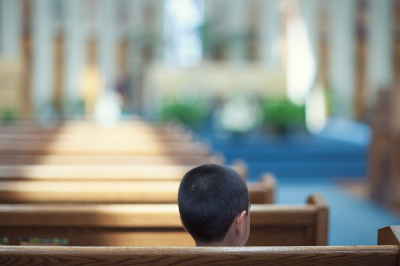
Every church has a dual calling when it comes to the evils of the world: ensure safety and confront danger.
- Ensure safety (internally): The church must be a place where every person is protected from harm.
- Confront danger (externally): The church is also called to send people out to preach the Gospel in dangerous places.
A safe church is a threat to the enemy. An unsafe church undermines the Gospel and is an asset to the enemy.
The high-trust and low-security environment
Churches, by nature, tend to be low-security and high-trust places. Their mission to welcome everyone and encourage attendance can make them vulnerable. With frequent gatherings and limited security checks, these environments can be perceived as soft targets for those with malicious intentions. Consider this matrix with different places. I’ve used the word “trust,” but you could replace it with “hospitality” and the same principles would apply.
High security and low trust: Everyone must go through security in airports. No exceptions. TSA agents assume anyone could be a risk and do not show much hospitality.
Low security and low trust: In shopping malls, anyone can come and go, and only a few shops contain security measures like metal detectors or armed guards. Most retailers have limited security. At the same time, these stores assume that anyone is a potential shoplifter. Hospitality and trust are not an emphasis.
High security and high trust: In many casinos, patrons are often treated with higher degrees of hospitality and trust. For the most part, anyone can play the games. Free drinks are offered as if you are an old friend or a longstanding client. But as we all know, hidden just behind the surface, these environments have some of the highest levels of security of any business in the world.
Low security and high trust: Churches have a unique environment in which guests are treated with high levels of hospitality and trust. If a church has a good first impressions ministry, new people receive parking spots of honor, free coffee or water, campus tours, welcome gifts, and a proper introduction to the pastor. Rarely does a church have metal detectors, armed guards, or any serious security measures.
Safe people, places, and systems
Safety within a church setting encompasses people, places, and systems. Unsafe conditions arise when one or more of these elements lack oversight or fall into neglect. For instance, trusting someone despite red flags or allowing unsupervised access to facilities can create vulnerabilities.
Churches must look honestly at their people and processes, ensuring that those in authority are held accountable, spaces are regularly maintained, and safety protocols are followed consistently. Harm occurs because one or more of these areas are unsafe. Safe churches have safe people, places, and systems.
New realities of church safety
Maintaining church safety is more challenging than ever. Unless you isolate yourself as a “spiritual island for the frozen chosen,” you’re bound to encounter situations that test your safety measures. The more a church serves its neighborhood, the messier safety becomes. More people coming into the church means more potential for harm.
- People are more aware than in the past. Always report every reasonable suspicion.
- Media outlets are quick to report church scandals. Whatever their motive, if someone is harmed, you should expect it to be covered by reporters. A coverup only exacerbates the harm of the incident.
- Since American churches are generally unhealthy, systemic problems exist. Wishing away systemic problems does not help.
- Church safety is as much a spiritual issue as a practical one. Satan is looking for easy targets. Unfortunately, he is finding them with our churches.
- Internal threats are more common than external threats. The strange guy in a dark trench coat is atypical. More common is the trusted, clean-cut individual no one suspects is grooming a child or family.
- The average age of a churchgoer is 60, and aging congregations have different safety problems and expectations. For example, ADA compliance has more of an impact on them than child check-in processes.
Churches today are tasked with a dual calling in a fallen world. They must ensure internal safety while also confronting external dangers. Internally, churches should be havens where everyone is protected from harm. Externally, they are called to go out and spread the Gospel, even in risky settings. Remember, a safe church is a threat to the enemy, and an unsafe church is an asset to the enemy.
Originally published at Church Answers.
Sam Rainer is president of Church Answers and pastor at West Bradenton Baptist Church in Florida.








